1. McMillan R. The pathogenesis of chronic immune thrombocytopenic purpura. Semin Hematol. 2007; 44(4 Suppl. 5):S3–S11. PMID:
18096470.

2. British Committee for Standards in Haematology General Haematology Task Force. Guidelines for the investigation and management of idiopathic thrombocytopenic purpura in adults, children and in pregnancy. Br J Haematol. 2003; 120:574–596. PMID:
12588344.
3. Kojouri K, Vesely SK, Terrell DR, George JN. Splenectomy for adult patients with idiopathic thrombocytopenic purpura: a systematic review to assess long-term platelet count responses, prediction of response, and surgical complications. Blood. 2004; 104:2623–2634. PMID:
15217831.

4. Mikhael J, Northridge K, Lindquist K, Kessler C, Deuson R, Danese M. Short-term and long-term failure of laparoscopic splenectomy in adult immune thrombocytopenic purpura patients: a systematic review. Am J Hematol. 2009; 84:743–748. PMID:
19714591.

5. Vesely SK, Perdue JJ, Rizvi MA, Terrell DR, George JN. Management of adult patients with persistent idiopathic thrombocytopenic purpura following splenectomy: a systematic review. Ann Intern Med. 2004; 140:112–120. PMID:
14734334.
6. Psaila B, Bussel JB. Refractory immune thrombocytopenic purpura: current strategies for investigation and management. Br J Haematol. 2008; 143:16–26. PMID:
18573111.

7. George JN, Woolf SH, Raskob GE, et al. Idiopathic thrombocytopenic purpura: a practice guideline developed by explicit methods for the American Society of Hematology. Blood. 1996; 88:3–40. PMID:
8704187.
8. Ruggeri M, Fortuna S, Rodeghiero F. Heterogeneity of terminology and clinical definitions in adult idiopathic thrombocytopenic purpura: a critical appraisal from a systematic review of the literature. Haematologica. 2008; 93:98–103. PMID:
18166791.

9. Balagué C, Vela S, Targarona EM, et al. Predictive factors for successful laparoscopic splenectomy in immune thrombocytopenic purpura: study of clinical and laboratory data. Surg Endosc. 2006; 20:1208–1213. PMID:
16865623.
10. Godeau B, Provan D, Bussel J. Immune thrombocytopenic purpura in adults. Curr Opin Hematol. 2007; 14:535–556. PMID:
17934364.

11. Bourgeois E, Caulier MT, Delarozee C, Brouillard M, Bauters F, Fenaux P. Long-term follow-up of chronic autoimmune thrombocytopenic purpura refractory to splenectomy: a prospective analysis. Br J Haematol. 2003; 120:1079–1088. PMID:
12648082.

12. Fabris F, Tassan T, Ramon R, et al. Age as the major predictive factor of long-term response to splenectomy in immune thrombocytopenic purpura. Br J Haematol. 2001; 112:637–640. PMID:
11260065.

13. Katkhouda N, Hurwitz MB, Rivera RT, et al. Laparoscopic splenectomy: outcome and efficacy in 103 consecutive patients. Ann Surg. 1998; 228:568–578. PMID:
9790346.
14. Kumar S, Diehn FE, Gertz MA, Tefferi A. Splenectomy for immune thrombocytopenic purpura: long-term results and treatment of postsplenectomy relapses. Ann Hematol. 2002; 81:312–319. PMID:
12107560.

15. Mazzucconi MG, Arista MC, Peraino M, et al. Long-term follow-up of autoimmune thrombocytopenic purpura (ATP) patients submitted to splenectomy. Eur J Haematol. 1999; 62:219–222. PMID:
10227454.

16. Pace DE, Chiasson PM, Schlachta CM, Mamazza J, Poulin EC. Laparoscopic splenectomy for idiopathic thrombocytopenic purpura (ITP). Surg Endosc. 2003; 17:95–98. PMID:
12360373.

17. Vianelli N, Galli M, de Vivo A, et al. Efficacy and safety of splenectomy in immune thrombocytopenic purpura: long-term results of 402 cases. Haematologica. 2005; 90:72–77. PMID:
15642672.
18. Wang T, Xu M, Ji L, Han ZC, Yang R. Splenectomy for adult chronic idiopathic thrombocytopenic purpura: experience from a single center in China. Eur J Haematol. 2005; 75:424–429. PMID:
16191093.

19. Schwartz J, Leber MD, Gillis S, Giunta A, Eldor A, Bussel JB. Long term follow-up after splenectomy performed for immune thrombocytopenic purpura (ITP). Am J Hematol. 2003; 72:94–98. PMID:
12555211.

20. George JN. Management of patients with refractory immune thrombocytopenic purpura. J Thromb Haemost. 2006; 4:1664–1672. PMID:
16879206.

21. George JN, Raskob GE, Vesely SK, et al. Initial management of immune thrombocytopenic purpura in adults: a randomized controlled trial comparing intermittent anti-D with routine care. Am J Hematol. 2003; 74:161–169. PMID:
14587042.

22. Johansson E, Engervall P, Landgren O, et al. Response to splenectomy is durable after a certain point in time in adult patients with chronic immune thrombocytopenic purpura. Eur J Haematol. 2006; 77:61–66. PMID:
16573739.

23. Portielje JE, Westendorp RG, Kluin-Nelemans HC, Brand A. Morbidity and mortality in adults with idiopathic thrombocytopenic purpura. Blood. 2001; 97:2549–2554. PMID:
11313240.

24. Cortelazzo S, Finazzi G, Buelli M, Molteni A, Viero P, Barbui T. High risk of severe bleeding in aged patients with chronic idiopathic thrombocytopenic purpura. Blood. 1991; 77:31–33. PMID:
1984800.

25. Provan D, Newland A. Fifty years of idiopathic thrombocytopenic purpura (ITP): management of refractory itp in adults. Br J Haematol. 2002; 118:933–944. PMID:
12199770.

26. McMillan R, Durette C. Long-term outcomes in adults with chronic ITP after splenectomy failure. Blood. 2004; 104:956–960. PMID:
15100149.

27. Zoghlami-Rintelen C, Weltermann A, Bittermann C, et al. Efficacy and safety of splenectomy in adult chronic immune thrombocytopenia. Ann Hematol. 2003; 82:290–294. PMID:
12739064.

28. Malfertheiner P, Megraud F, O'Morain C, et al. Current concepts in the management of Helicobacter pylori infection: the Maastricht III Consensus Report. Gut. 2007; 56:772–781. PMID:
17170018.

29. Stasi R, Sarpatwari A, Segal JB, et al. Effects of eradication of Helicobacter pylori infection in patients with immune thrombocytopenic purpura: a systematic review. Blood. 2009; 113:1231–1240. PMID:
18945961.

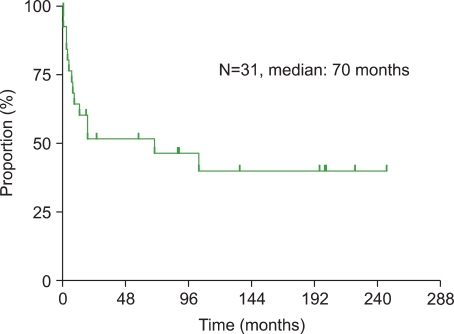
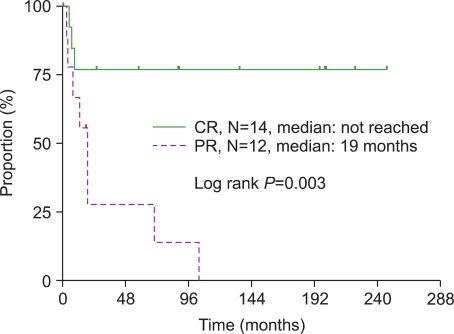
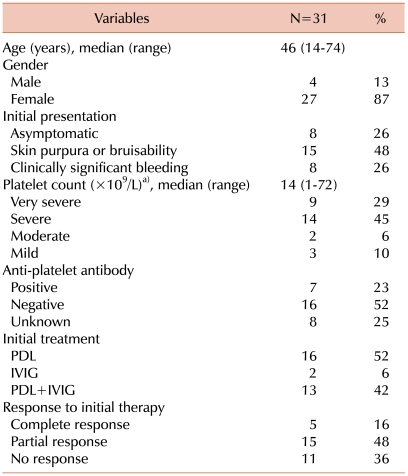

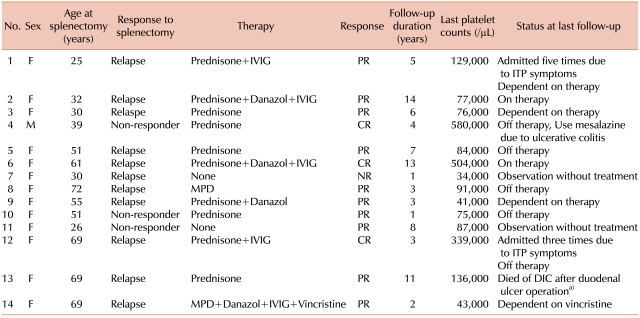




 PDF
PDF ePub
ePub Citation
Citation Print
Print


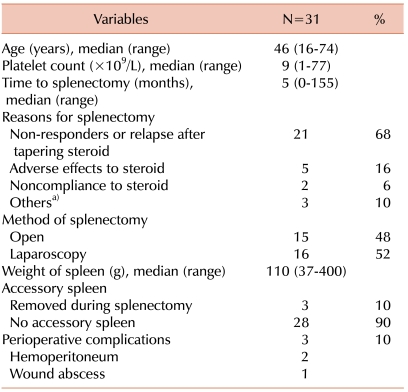
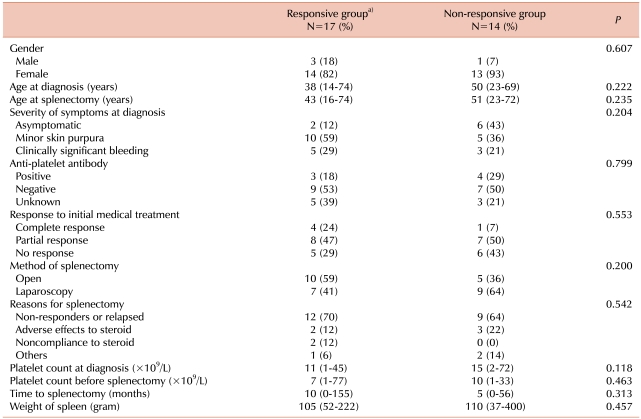
 XML Download
XML Download